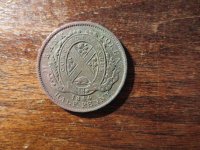Gypsy Heart
Gold Member
During the Civil War, the city of St. Louis found itself in the predicament of being loyal to the Union in a state that was predominately dedicated to the Confederate cause. For this reason, men who were part of what was called the Home Guard were picketed along the roads and trails leading into the city with instructions to turn back Southern sympathizers by any means necessary. As a result, Confederate spies, saboteurs and agents often had to find less trafficked paths to get in and out of the St. Louis area. One of the lesser known trails was leading to and away from the ford across the Meramec River near Glencoe. This trail would later be known as Lawler Ford Road.
Located in Wildwood, which was formerly Ellisville, and Glencoe, the road can be reached by taking Manchester Road out west of the city to Old State Road South. By turning down Ridge Road to the Ridge Meadows Elementary School, curiosity seekers could find the road just to the left of the school. For years, it was marked with a sign but it has since disappeared. Only a chained gate marks the entrance today.
The first white settler in the area was Ninian Hamilton from Kentucky. He arrived near Glencoe around 1800 and obtained a settler's land grant. He built a house and trading post and became one of the wealthiest and most influential men of the period. It was mentioned that the area around Glencoe was a pivotal point in western movement. In those days, the Meramec River bottoms were heavily forested and made up of steep hills and sharp bluffs. The river flooded frequently and the fords that existed were only usable during times of low water. There were no bridges or ferries that crossed the river, except for one that was operated far to the southeast. The trappers and traders that traveled west of St. Louis, like the Indians before them, came on horseback along the ridge route that later became Manchester Road. It skirted the Meramec and was high enough so that it was not subject to flooding. Because of this, it passed directly by Hamilton's homestead and the trading post that he established here. With the well-used trail just outside of his backdoor, as well as nearby fish, game and spring water, Hamilton's post prospered.
Hamilton later built some grist mills near his trading post, which was a badly needed resource for settlers in those days. There are also legends that say that annual gatherings of fur trappers and Indian traders occurred at Hamilton's place. These rendezvous have been the subject of great debate over the years but no one knows for sure if they occurred. It is known that his post was the last one leaving St. Louis and the first the trappers would see when returning, so it's likely they did take place.
Many visitors also claim to have had strange experiences near the old shacks and ramshackle homes located along the beach area at the end of the trail. One of the long-standing legends of the place mentions the ghost of an old woman who screams at people from the doorways of one of the old houses. However, upon investigation, the old woman is never there. The houses here date back to about 1900, when the area around Glencoe served as a resort community. The Meramec River's "clubhouse era" lasted until about 1945. Many of the cottages were then converted to year-round residences but others were simply left to decay and deteriorate in the woods.
::::::::::::::::::::::::::::::::::::::
NINIAN HAMILTON was born in Kentucky in 1783, and in 1803 settled on Survey seven hundred and sixty-six where the Old State Road crossed the valley. He built a house and was one of the most enterprising men of the times.� He died about 1834.� Ninian (2) was born in 1809 and died in 1856.� His grandmother died in 1851, aged one hundred and four...
Historian Louis Houck placed Hamilton at this location in 1800.
Hamilton was a trader and farmer.� His location on this tract coincided with the influx of American settlers from the east.� Earlier, neither French nor Spanish governors welcomed non-Catholic settlers officially, though the Spanish were more liberal.
Hamilton settled this location prior to the official transfer of Louisiana from France to the United States.
Ninian Hamilton settled on what would become Survey 766 (included LaSalle Fathers� land to Hwy 109 and Yeatman-Carr-McMahon land to the south but none in Rockwoods Reservation) after the United States survey was made in 1818.� Records of the Missouri Land Survey indicate that this was a settler's grant of 640 acres.� It was not a French or Spanish land grant, though we can be sure that the Spanish governors knew of his location at thius point.� This 640 acres equals one section of land under the United States' method of surveying.
Andrew Hamilton obtained a settlers' grant of 400 arpens (340.28 acres) directly west of Ninian's grant (Survey 2032.)
A much larger land grant, either French or Spanish, adjoined the Hamilton tract to the south.� This was the Louis Courtois, Junior grant of 7056 arpens, or 6,002.50 acres which included the present town site of Glencoe, the land along the bluffs of the Meramec and much of what is now the town of Eureka (Survey 3206.)� There is no record of any Courtois settling in the area.
http://www.rollanet.org/~conorw/cwome/glencoe-from_the_beginning.htm
Located in Wildwood, which was formerly Ellisville, and Glencoe, the road can be reached by taking Manchester Road out west of the city to Old State Road South. By turning down Ridge Road to the Ridge Meadows Elementary School, curiosity seekers could find the road just to the left of the school. For years, it was marked with a sign but it has since disappeared. Only a chained gate marks the entrance today.
The first white settler in the area was Ninian Hamilton from Kentucky. He arrived near Glencoe around 1800 and obtained a settler's land grant. He built a house and trading post and became one of the wealthiest and most influential men of the period. It was mentioned that the area around Glencoe was a pivotal point in western movement. In those days, the Meramec River bottoms were heavily forested and made up of steep hills and sharp bluffs. The river flooded frequently and the fords that existed were only usable during times of low water. There were no bridges or ferries that crossed the river, except for one that was operated far to the southeast. The trappers and traders that traveled west of St. Louis, like the Indians before them, came on horseback along the ridge route that later became Manchester Road. It skirted the Meramec and was high enough so that it was not subject to flooding. Because of this, it passed directly by Hamilton's homestead and the trading post that he established here. With the well-used trail just outside of his backdoor, as well as nearby fish, game and spring water, Hamilton's post prospered.
Hamilton later built some grist mills near his trading post, which was a badly needed resource for settlers in those days. There are also legends that say that annual gatherings of fur trappers and Indian traders occurred at Hamilton's place. These rendezvous have been the subject of great debate over the years but no one knows for sure if they occurred. It is known that his post was the last one leaving St. Louis and the first the trappers would see when returning, so it's likely they did take place.
Many visitors also claim to have had strange experiences near the old shacks and ramshackle homes located along the beach area at the end of the trail. One of the long-standing legends of the place mentions the ghost of an old woman who screams at people from the doorways of one of the old houses. However, upon investigation, the old woman is never there. The houses here date back to about 1900, when the area around Glencoe served as a resort community. The Meramec River's "clubhouse era" lasted until about 1945. Many of the cottages were then converted to year-round residences but others were simply left to decay and deteriorate in the woods.
::::::::::::::::::::::::::::::::::::::
NINIAN HAMILTON was born in Kentucky in 1783, and in 1803 settled on Survey seven hundred and sixty-six where the Old State Road crossed the valley. He built a house and was one of the most enterprising men of the times.� He died about 1834.� Ninian (2) was born in 1809 and died in 1856.� His grandmother died in 1851, aged one hundred and four...
Historian Louis Houck placed Hamilton at this location in 1800.
Hamilton was a trader and farmer.� His location on this tract coincided with the influx of American settlers from the east.� Earlier, neither French nor Spanish governors welcomed non-Catholic settlers officially, though the Spanish were more liberal.
Hamilton settled this location prior to the official transfer of Louisiana from France to the United States.
Ninian Hamilton settled on what would become Survey 766 (included LaSalle Fathers� land to Hwy 109 and Yeatman-Carr-McMahon land to the south but none in Rockwoods Reservation) after the United States survey was made in 1818.� Records of the Missouri Land Survey indicate that this was a settler's grant of 640 acres.� It was not a French or Spanish land grant, though we can be sure that the Spanish governors knew of his location at thius point.� This 640 acres equals one section of land under the United States' method of surveying.
Andrew Hamilton obtained a settlers' grant of 400 arpens (340.28 acres) directly west of Ninian's grant (Survey 2032.)
A much larger land grant, either French or Spanish, adjoined the Hamilton tract to the south.� This was the Louis Courtois, Junior grant of 7056 arpens, or 6,002.50 acres which included the present town site of Glencoe, the land along the bluffs of the Meramec and much of what is now the town of Eureka (Survey 3206.)� There is no record of any Courtois settling in the area.
http://www.rollanet.org/~conorw/cwome/glencoe-from_the_beginning.htm




